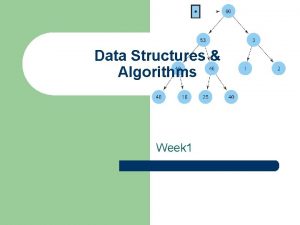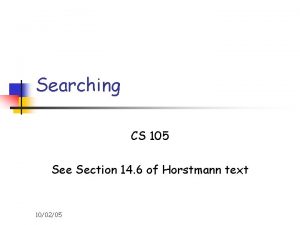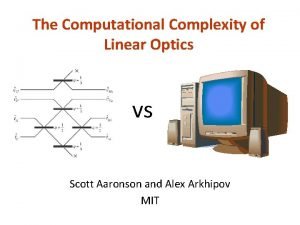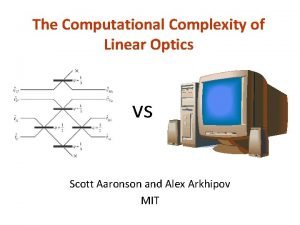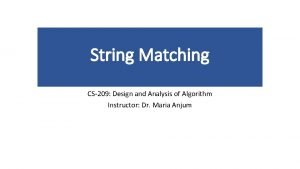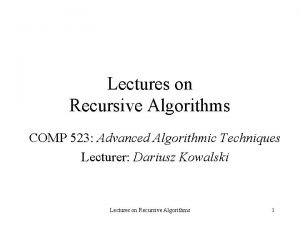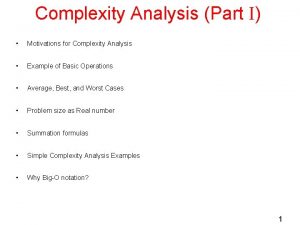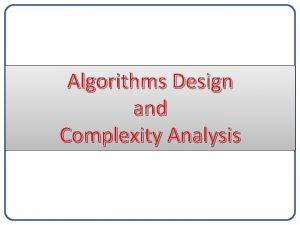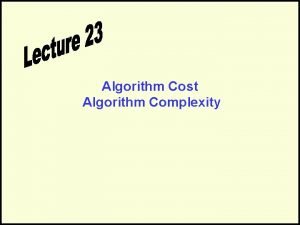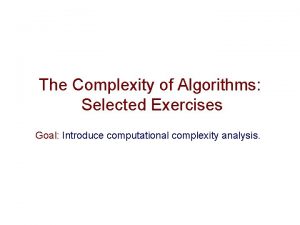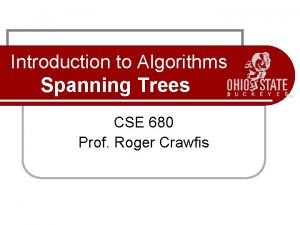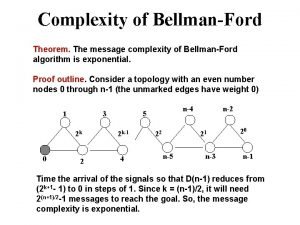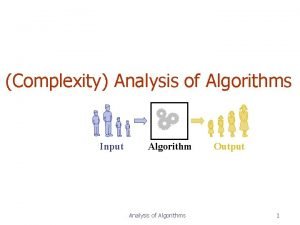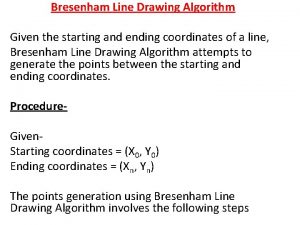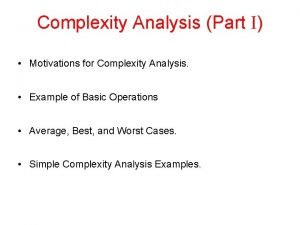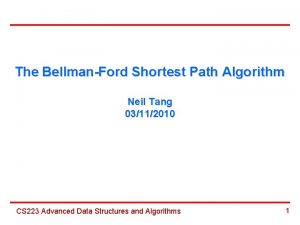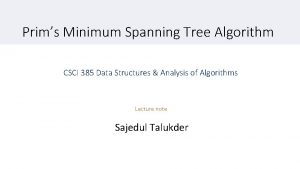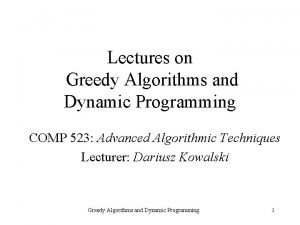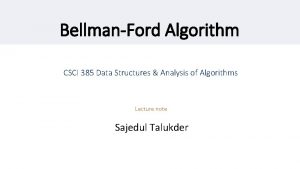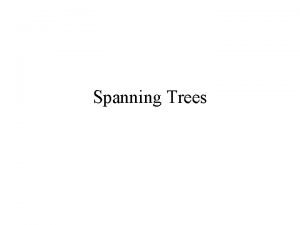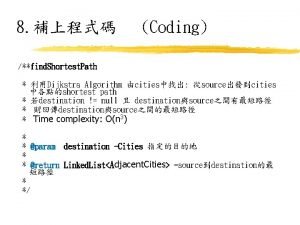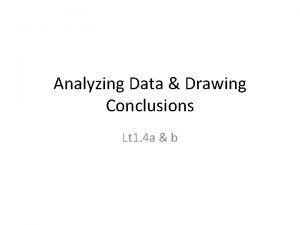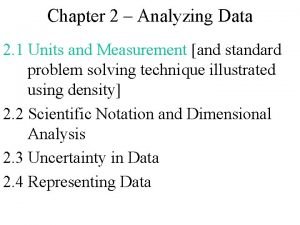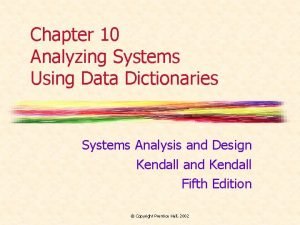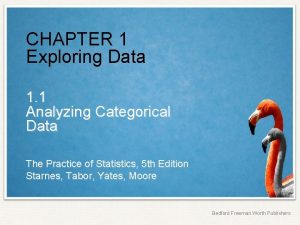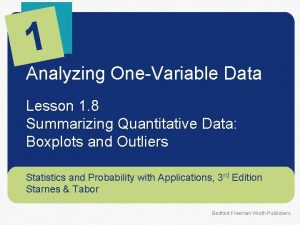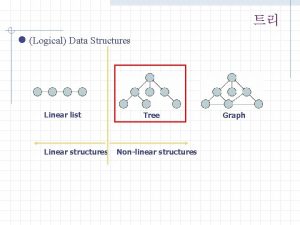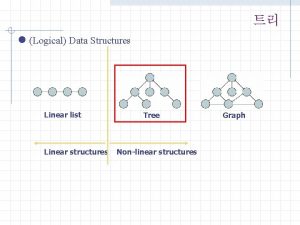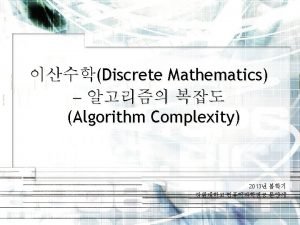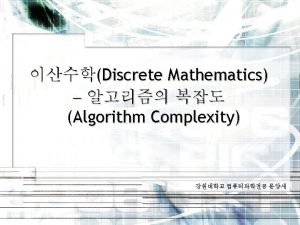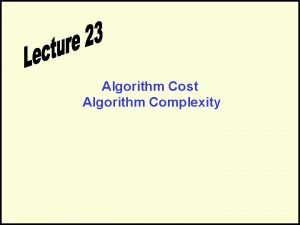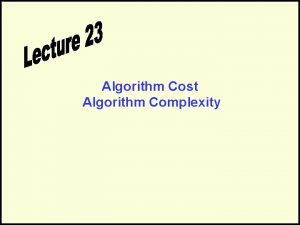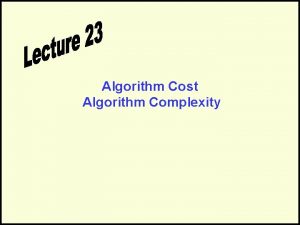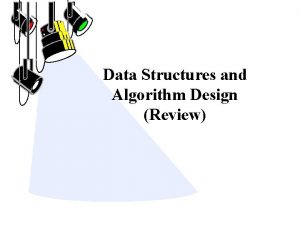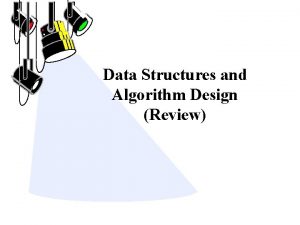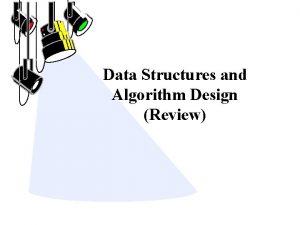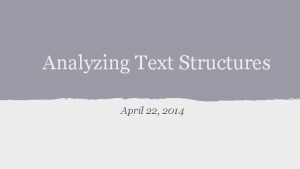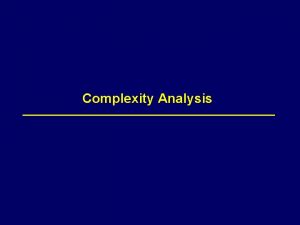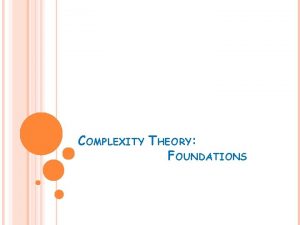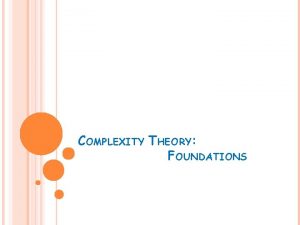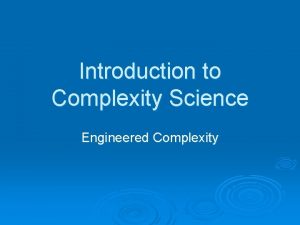Algorithm Complexity Linear Data Structures Analyzing Algorithm Complexity

































![Solution: Array. List public class Array. List<T> : IEnumerable<T> { private T[] items; } Solution: Array. List public class Array. List<T> : IEnumerable<T> { private T[] items; }](https://slidetodoc.com/presentation_image_h2/3ca25d5b60a95f055fd54a0088f86f05/image-34.jpg)







- Slides: 41

Algorithm Complexity, Linear Data Structures Analyzing Algorithm Complexity, Asymptotic Notation Data Structu res Soft. Uni Team Technical Trainers Software University http: //softuni. bg

Table of Contents 1. Complexity of Algorithms § Algorithm Count of Operations § Best, Average and Worst Case § Asymptotic Notation – O(g) 2. Linear Data Structures § Arrays § Dynamic Arrays 2

Have a Question? sli. do #Ds. Algo 3

Algorithm Complexity Asymptotic Notation

Algorithm Analysis § Why should we analyze algorithms? § Predict the resources the algorithm will need § Computational time (CPU consumption) § Memory space (RAM consumption) § Communication bandwidth consumption § Hard disk operations 5

Algorithm Analysis (2) § The expected running time of an algorithm is: § The total number of primitive operations executed (machine independent steps) § Also known as algorithm complexity § Compare algorithms ignoring details such as language or hardware 6

Algorithmic Complexity § What to measure? § CPU time § Memory consumption § Number of steps § Number of particular operations § Number of disk operations § Number of network packets § Asymptotic complexity 7

Problem: Get Sum Number of Steps § Calculate maximum steps to find sum of even elements in an array Solution: int Get. Sum. Even(int[] array) T(n) = 9 n + 3 { int sum = 0; for (int i = 0; i < array. Length; i++) if (array[i] % 2 == 0) sum += array[i]; return sum; Counting maximum steps is } called worst-case analysis § Assume that a single step is a single CPU instruction: § assignments, array lookups, comparisons, arithmetic operations 8

Time Complexity § Worst-case § An upper bound on the running time § Average-case § Average running time § Best-case § The lower bound on the running time (the optimal case) 9

Problem: Contains Number of Steps § Calculate maximum steps to find if an element is in an array Solution: int Contains(int[] array, int element) T(n) = 4 n + 4 { for (int i = 0; i < array. Length; i++) if (array[i] == element) return true; return false; } § Assume that a single step is a single CPU instruction like: § assignments, array lookups, comparisons, arithmetic operations 10

Simplifying Step Count § Some parts of the equation grow much faster than others n = 1000 steps: 4000 + 4 int Contains(int[] array, int element) { for (int i = 0; i < array. Length; i++) if (array[i] == element) return true; return false; Relevant part: n } § Higher terms dominate lower terms – n > 2, n 2 > n, n 3 > n 2 § Multiplicative constants can be omitted – 12 n n, 2 n 2 11

Problem: Fibonacci Number of Steps § Calculate steps to find nth Fibonacci number recursively Solution: T(n) = 3 + T(n - 1) + T(n - 2) int Fibonacci(int n) { if (n == 0) return 1; else if (n == 1) return 1; else return Fibonacci(n-1) + Fibonacci(n-2); } § but Fn = Fn – 1 + Fn – 2 which is ≤ T(n) § but, for example F 40 = 102, 334, 155! Steps: 20. 694 n ≈ (1. 6)n 12

Fibonacci Recursion Tree § fib(n) makes about fib(n) recursive calls § The same value is calculated many, many times! 13

Algorithms Complexity § Algorithm complexity – rough estimation of the number of steps performed by given computation, depending on the size of the input § Measured with asymptotic notation § O(f(n)) – read "Big oh of f(n)" § Θ(f(n)) – read "Theta of f(n)" § Ω(f(n)) – read "Omega of f(n)" § where f(n) is a function of the size of the input data 14

Asymptotic Notations § O(f(n)) – Upper bound § j = O(g) § j = O(h) § Θ(f(n)) – Upper & Lower bound § j = Θ(j) § g = Θ(g) § Ω(f(n)) – Lower bound § h = Ω(j) § g = Ω(j) 15

Asymptotic Notation: Definition § For a given function g(n), we denote by O(g(n)) the set of functions that are different than g(n) by a constant O(g(n)) = {f(n): there exist positive constants c and n 0 such that f(n) <= c*g(n) for all n >= n 0} § Examples: § 2 * n 2 + 10 ∈ O(n 2) § 10 n + 4 ∈ O(n) § 4*n*log 2(3*n+1) + 2*n-1 ∈ O(n * log n) 16

Functions Growth Rate § О(n) means a function grows linearly when n increases § E. g. ƒ(n)=n+1 § O(n 2) means a function grows exponentially when n increases § E. g. ƒ(n)=n 2+2 n+2 § O(1) means a function does not grow when n changes § E. g. ƒ(n)=4 ƒ(n) 18 17 16 15 14 13 12 11 10 9 8 7 6 5 4 3 2 1 0 0 1 2 3 4 5 6 7 8 9 10 11 12 13 14 15 n 17

Asymptotic Functions 18

Typical Complexities Complexity Notation constant logarithmic linearithmic quadratic cubic exponential O(1) O(log n) O(n*log n) O(n 2) O(n 3) O(nn) Description n = 1 000 1 -2 operations n = 1 000 10 operations n = 1 000 10 000 operations n = 1 000 000 operations n = 10 000 000 operations 19

Function Values 20

Time Complexity and Program Speed Complexity 10 20 50 100 O(1) <1 s <1 s O(log(n)) <1 s <1 s <1 s <1 s O(n*log(n)) <1 s <1 s O(n 2) <1 s <1 s <1 s 2 s 3 -4 min O(n 3) <1 s <1 s 20 s 5 hours 231 days O(2 n) <1 s hangs O(n!) <1 s hangs hangs O(nn) 3 -4 min hangs hangs 260 days hangs 1 000 100 000 21

Memory Requirement § Memory consumption should also be considered, for example: § Storing elements in a matrix of size N § Filling the matrix – Running time O(n 2) § Get element by index – Running time O(1) § Memory requirement O(n 2) 22

Linear Data Structures Arrays, Resizable Lists, Linked Lists

Abstract Data Types (ADT) § An Abstract Data Type (ADT) is § A data type together with the operations, whose properties are specified independently of any particular implementation § ADT can have several different implementations § Example: § List – variable sized, ordered sequence of elements that supports § Add, Get, Set, Remove § Can be implemented using an array, or a list of linked nodes 24

What is a Data Structure? “In computer science, a data structure is a particular way of storing and organizing data in a computer so that it can be used efficiently. ” -- Wikipedia § Examples of data structures: § Person structure (first name + last name + age) § Array of integers – int[] § List of strings – List<string> § Queue of people – Queue<Person> 25

2 4 1 3 5 Array Data Structures Built-in and Lightweight

Array Data Structure § Ordered § Very lightweight § Has a fixed size § Usually built into the language § Many collections are implemented by using arrays, e. g. § List<T> in. NET § Array. List<T> in Java 27

Why Arrays Are Fast? § Arrays use a single block of memory Int 32 uses 4 bytes int[] array = { 2, 4, 1, 3, 5 }; § Uses total of array pointer + (N * element/pointer size) 2 4 1 Array starts at this address 3 5 Total: 5 * 4 bytes § Array Address + (Element Index * Size) = Element Address § Array Element Lookup – O(1) 28

Arrays – Changing Array Size § Arrays have a fixed size § Memory after the array may be occupied § If we want to resize the array we have to make a copy Free for garbage collection 2 4 2 1 4 3 1 5 3 0 5 0 0 May be occupied § Array Copy – O(n) 29

2 4 1 3 5 List Data Structure Resizing Arrays

Dynamic Arrays (Lists) § Has a variable size § Implemented using an array New array with copied elements List 2 4 1 3 5 Add Remove Count = 5 Add O(n) Get O(1) Set O(1) 2 4 1 3 5 1 Count = 6 Remove O(n) 31

Dynamic Arrays (Lists) – Add O(1) § Doubles its capacity when needed § Copying occurs at log(n) n = 109, only ~30 copies List 2 Capacity = 2 Count = 1 Add Amortized O(1) 2 4 2 Capacity = 2 Count = 2 4 1 Capacity = 4 Count = 3 Add O(n) 32

Problem: Array. List § Create an Array. List<T> data structure, which supports Same name, without namespace § Count § Indexer[] – get and set § void Add(T) – O(1) §T Remove. At(int) – O(n) throws Index. Out. Of. Range § Double array if count == capacity § Shrink array if count <= capacity / 4 33
![Solution Array List public class Array ListT IEnumerableT private T items Solution: Array. List public class Array. List<T> : IEnumerable<T> { private T[] items; }](https://slidetodoc.com/presentation_image_h2/3ca25d5b60a95f055fd54a0088f86f05/image-34.jpg)
Solution: Array. List public class Array. List<T> : IEnumerable<T> { private T[] items; } public int Count { get; private set; } T this[int index] {} public void Add(T item) {} T Get(int index) {} void Set(int index, T T Remove. At(int index) item) {} {} 34

Solution: Array. List Add: if (Count == Capacity) Resize (Capacity * 2) add item at index Count increment Count Get: check if index is valid return the item at index 35

Solution: Array. List (2) Set: check if index is valid set the item at index Remove: check if index is valid remove item (Make sure to clean reference) shift remaining elements left decrement count if (Count == Capacity / 4) shrink Array (halve Capacity) 36

Linear Data Structures Live Exercises in Class (Lab)

Summary § Algorithm complexity is a rough estimation of the number of steps performed by given computation § Data structures organize data in computer systems for efficient use § Abstract data types (ADT) describe a set of operations § Arrays are a lightweight data structure that has constant time access to elements but has a fixed size § Lists are a variable size data structures 38

Algorithm Complexity and Linear Data Structures ? s n stio e u Q ? ? ? https: //softuni. bg/courses/programming-fundamentals

License § This course (slides, examples, labs, videos, homework, etc. ) is licensed under the "Creative Commons Attribution. Non. Commercial-Share. Alike 4. 0 International" license § Attribution: this work may contain portions from § "Fundamentals of Computer Programming with C#" book by Svetlin Nakov & Co. under CC-BY-SA license § "Data Structures and Algorithms" course by Telerik Academy under CC-BY-NC-SA license 40

Free Trainings @ Software University § Software University Foundation – softuni. org § Software University – High-Quality Education, Profession and Job for Software Developers § softuni. bg § Software University @ Facebook § facebook. com/Software. University § Software University @ You. Tube § youtube. com/Software. University § Software University Forums – forum. softuni. bg
 Space complexity of nested loops
Space complexity of nested loops Define macro processor
Define macro processor Assembler algorithm and data structures
Assembler algorithm and data structures Data structures and algorithm
Data structures and algorithm Homologous structure
Homologous structure Worst case time complexity of linear search
Worst case time complexity of linear search The computational complexity of linear optics
The computational complexity of linear optics The computational complexity of linear optics
The computational complexity of linear optics V5-7gzofadq -site:youtube.com
V5-7gzofadq -site:youtube.com Recursion time complexity
Recursion time complexity Depth first search algorithm complexity
Depth first search algorithm complexity Binary search big o
Binary search big o What is complexity analysis
What is complexity analysis Dfsdef
Dfsdef How to find complexity of algorithm
How to find complexity of algorithm Algorithm complexity
Algorithm complexity Algorithm complexity exercises
Algorithm complexity exercises Kruskal complexity
Kruskal complexity Bellman ford algorithm complexity
Bellman ford algorithm complexity Algorithm complexity analysis
Algorithm complexity analysis Why is the complexity of bresenham line drawing algorithm
Why is the complexity of bresenham line drawing algorithm Big o functions
Big o functions Complexity analysis examples
Complexity analysis examples Bellman ford
Bellman ford Algorithm complexity
Algorithm complexity Greedy algorithm time complexity
Greedy algorithm time complexity Bellman ford algorithm
Bellman ford algorithm Time complexity of prims algorithm
Time complexity of prims algorithm Discover d
Discover d Dijkstra algorithm time complexity
Dijkstra algorithm time complexity Analyzing ethnographic data
Analyzing ethnographic data What conclusion can you draw out from the pie graph
What conclusion can you draw out from the pie graph Chapter 2 analyzing data
Chapter 2 analyzing data Chapter 2 analyzing data answer key
Chapter 2 analyzing data answer key Analyzing systems using data dictionaries
Analyzing systems using data dictionaries Analyzing and visualizing data with microsoft power bi
Analyzing and visualizing data with microsoft power bi Interpreting quantitative data
Interpreting quantitative data Analyzing categorical data
Analyzing categorical data Lesson 1.8 boxplots and outliers
Lesson 1.8 boxplots and outliers Experimental design in quantitative research
Experimental design in quantitative research Analyzing and interpreting data in research
Analyzing and interpreting data in research Analyzing and interpreting data in research
Analyzing and interpreting data in research



